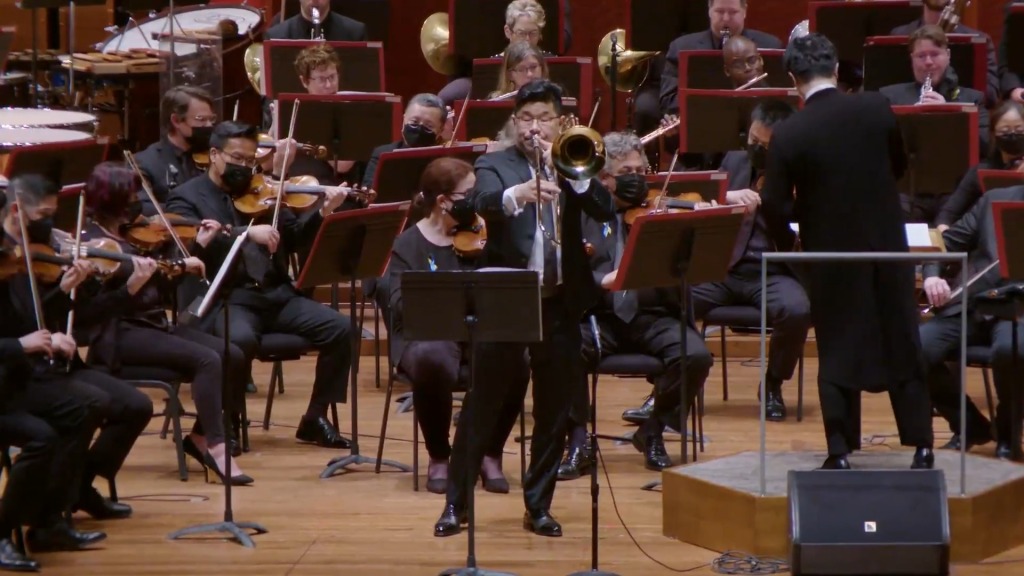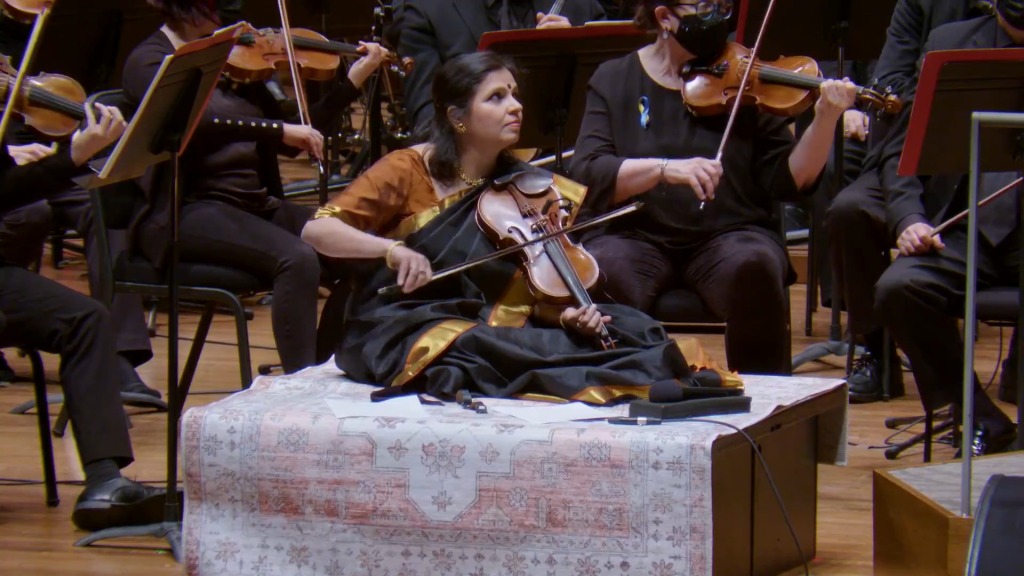
Toshio Hosokawa: Meditation
Tan Dun: Trombone Concerto – Three Muses in Video Game (2022)
Ko-ichiro Yamamoto (soloist)
Kala Ramnath & Reena Esmail: Concerto for Hindustani Violin (2022)
Kala Ramnath (soloist)
Claude Debussy – La Mer (1903-5)
As this is a blog that literally no one reads, I am not particularly worried about stating unequivocally something that, in today’s knotted, virtue-signaling echo chamber, would undoubtedly be considered “racist” by SOMEONE: The best thing about Seattle is the large Asian population. (By Asian, I refer to ALL of Asia – SE, S and SW.) The Northwest rim has a lot going for it – natural beauty always on the periphery, nighttime temperatures in the 50s in midsummer (for now, at least), elected officials who don’t embarrass the human species, a massive natural boundary (mountains and desert) between it and the Nazis in the interior – but it is those times when I am walking around and feel like I am in a foreign country that I feel most grateful to be here. While I am utterly sick of identity politics and all of that, I am pretty burned out on “Western Civilization”…
Really, I’m pretty sick of everything. Not post-Mahlerian classical music (which I consider one of the only legit dissident art forms)… And springtime. Effing LOVE springtime. Tulips, fruit tree blossoms, spring training baseball, pretty much everything except the income tax ritual.
March 20 was the first day of spring, and it was also the only performance of this concert, the 14th annual “Celebrate Asia” event, so it was all set up to be a wonderful day, and that is how it played out.
The concert featured works by three living composers (one Japanese, one Chinese, and one Indian-American (in collaboration with an Indian virtuoso) I’m interested in, and a dead one who’s always worth hearing live but probably should not have been on this bill…
The Japanese composer Toshio Hosokawa (b. 1955) is “full-avant garde”, with much of his discography on Wergo and Kairos. I’ve liked a lot of his music that I’ve heard, and this piece was fine, but not particularly engaging. Its subject was 3.11, which is how the Japanese refer to the tsunami that devastated Fukashima and its nuclear power plant. It used some isolated timpani to arresting effect, but the overall vibe was, as the title would suggest, vaguely eerie and chill. The earth thudded but at no point did the wave crash into the shore. Not super memorable but an OK table-setter. Kahchun Wong’s left hand was the most entertaining element of the performance.
Tan Dun (b. 1957) is probably the most successful composer – in terms of sales and visibility, with most of his releases on majors like Sony – to be routinely left out of conversations about important living composers. That no doubt owes to the fact that his music sounds immediately Chinese. Not chintzy or gimmicky but unmistakably. And to the fact he is best-known for “rousing” film scores, like his Oscar-winner for Crouching Tiger, Hidden Dragon. But his serious work is performed by upper echelon artists, like the Kronos Quartet, who do not pander. All of that said, I was not really looking forward to this piece, as I had my doubts about the trombone’s capacity for profundity, and “Video Game” in the title, to me, suggested “Game Over” before I’d found my seat…
However. I can say without hesitation the concerto – a joint commission from the Seattle Symphony and Royal Concertgebouw trombonist Jorgen van Rijen, was a friggin’ BLAST. My reservations were obliterated almost immediately, blown to bits like a lumbering Round 1 asteroid. The trombone is indeed a concerto-worthy instrument. Tan Dun’s concerto showed off its expressive range, from almost tuba-like oomph to trumpet-like rat-a-tat. Its ability to slide and swoop between tones was exploited throughout. Because we in the West tend to associate such shenanigans with slapstick humor, I found myself on the cusp of a chortle from time to time, catching myself just as the slide resolved on a note of real weight. As conductor Wong pointed out after the intermission, Tan Dun was mimicking the four different intonations employed by Mandarin speakers throughout.
As for the video game business, I heard nothing. But then I have not played a video game since NBA 2K was new.
And soloist Ko-ichiro Yamamoto, Principal Trombonist of the Seattle Symphony, totally sold it. A powerfully built fireplug of a man – his picture in the concert program showed him in downhill ski gear – he brought buoyant energy to the stage without having to try. In smartly tapered trousers and snug blazer, he called to mind a swing orchestra soloist, bouncing on his feet, itching to blare. And blare he did, over a spacious tableau that – in terms of film music, which it frequently suggested – suggested Shostakovich as much as John Williams. Really, the overall effect was more in the Ennio Morricone vein than anything else. Which is to say, tightly paced and liberally peppered with quirky sounds and ridiculously catchy melodies. I would venture that if orchestras presented more stuff like this, they might find their audience demographics tilting younger…
Not til she was in her late twenties did Chicago-born Reena Esmail (b. 1983) commence exploring Hindustani (or Northern Indian) classical music. Since receiving a Fulbright-Nehru fellowship that allowed her to study in New Delhi with the renowned sitarist Gaurav Mumzadar in 2011-12, Esmail has worked to bridge the cultures in an artistically satisfying manner. Which is easier said than done – witness the less-than-satisfying sitar concertos Ravi Shankar recorded in the ’70s. The phrase “Indian classical music”, which suggests affinities with the Western brand, but Indian classical music refers to the traditional music of the subcontinent and is almost entirely improvisational and is played by small ensembles. It is a wide gulf, then, but the concerto for Hindustani violin that Esmail co-authored with soloist Kala Ramnath (b. 1967) would seem to suggest that Esmail’s bridge is now safe for traffic.

Of course, the success in bridging East and West that Esmail and Ramnath’s concerto evinced – in fairness to Shankar – undoubtedly owes in large part to the instrument. While, to Western sensibilities, the sitar is as thoroughly foreign a conception of a musical instrument as anything that might be fashioned from wood and wire, the Hindustani violin is, in essence, a Western violin. Indian violins tend to be constructed from denser wood than Western ones, but aside from that it is the differences in tuning (very different) and the manner in which it is played – seated, with the instrument pointed downward, the scroll resting on the crossed legs of the performer – that defines a “Hindustani violin.” The effect of the tuning and posture is – no surprise – considerably more nasal in tone, with a drone implied if not in effect at all times. It sounds, in short, far more like a human voice – or a slide guitar – than a violin in Western classical music. Ramnath, who lives in California these days, occupies Shankar-like status in today’s Hindustani music world and her playing flows like a stream. Eerily calm (at least to my perpetually agitated Western soul) and smiling beatifically, she sat on a low platform immediately to the left of Wong and focused her attention on his conducting when she wasn’t inwardly focused. The concerto stressed repetitive phrases and the orchestra locked into grooves for extended periods, but followed a more Westernized sense of progress than a raga. It was divided into five short-ish movements, one for each of the principal elements in the Hindu worldview (fire, water, earth, air and space), and within each was an examination of that element in a world out of balance and then in harmony with the others. (Esmail explained this in a helpful introduction to the piece.)
This piece was more on the sublime side than the Tan Dun concerto but just as moving. My verdict, for whatever it’s worth: There need to be more concertos written for Hindustani violin.
Esmail and Ramnaths’s concerto would have been a perfect concert closer. A two-minute standing ovation (seemed longer), two curtain calls… It put Debussy in a somewhat awkward position.
It was left to conductor Wong to explain the presence of La Mer on an otherwise all-Asian program, which he did as Ramnath’s platform was disassembled and offloaded. He pointed out Debussy’s fondness for Japanese woodblock prints and his use of the 1836 Hokusai woodblock print “The Great Wave off Kanagawa” (-you know, “The Scream” of woodblock prints) on the 1905 sheet music for La Mer. (Kahchun pointed out that he and his wife currently reside in Kanagawa, where he is often reminded of the print, which certainly represents both a coincidence and a reach…)
Of course, Debussy’s ties to Asia were of course more substantial than a woodblock print (and definitely more tangible than Tchaikovsky’s…) Debussy had been enthralled by gamelan music at the Javanese pavilion at the 1889 Paris Exposition Universelle and by the time he began La Mer fourteen years later, the East was in his bloodstream. (1903 was also the year he wrote Pagodes, his attempt to capture the nuances of the gamelan on a Western piano.) Kahchun led a sprightly rendition, and it fit fine.
The fact of the matter, though, is Debussy wrote La Mer about the Mediterranean, and he is 100 years older, 100% more European, and 100% deader than the other composers on the program. The audience for this show, meanwhile, was about 70% Asian and 100% alive. I wonder if it would be viable for the Seattle Symphony at some time in the near future to present two distinct concert series and scotch the hybrid action. One series, twelve or so concerts, that followed the present S.O.P., with European “masterworks” serving as the crux and more offbeat works as first-half table-setters; and then a second, shorter series of concerts, six or so, that consciously catered to Seattle’s demographic and highlighted living Asian, American (including South and Central), and female composers… It might be worth a thought.
